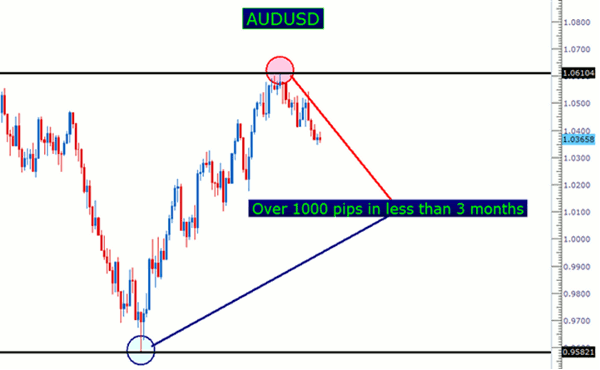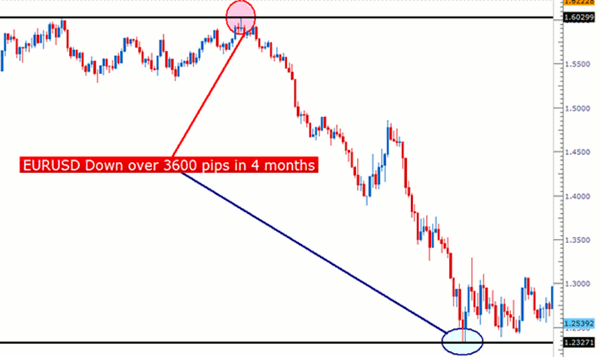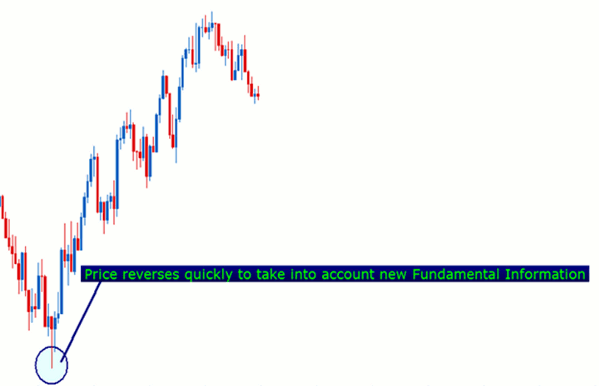James Stanley of DailyFX.com explains how successful currency traders make money on reversal trades, and avoid big losses while doing so.
One of the more exciting trading strategies is also one of the most dangerous, and that is trading reversals.
After all, who wouldn’t have liked to hit the AUD/USD move from June 1, when we’ve seen price move up over 1,000 pips in slightly less than three months:
Or perhaps a trader was fortunate enough to catch the turn in EUR/USD just before the financial collapse of 2008. That’s over 3,600 pips in only four months.
These are some big moves, without a doubt, and even the best traders don’t capture the entire move. But what isn’t readily visible from this chart (and nearly impossible to calculate) is the massive number of traders in between these two moves that tried and failed to catch these reversals.
New traders continue to get torn up attempting to catch these large price changes, attempting to buy "absolute bottoms" or sell "absolute tops." This article will attempt to prescribe a manner in which traders can look for price reversals while focusing on one of the more important elements of trading: risk management.
Next: What Creates Reversals?
|pagebreak|What Creates Reversals?
Reversals can occur in a market for a number of reasons. Price can retreat from a given move at any point in time, but the chief culprit will always be the same: supply and demand, which dictates price at all times in a true market environment.
When buyers outnumber sellers, demand (from people wanting to buy) outstrips supply (from people wanting to sell), and price correspondingly goes up. If sellers outnumber buyers, then it can be said that there is more supply than demand. And just like that fashion accessory that went out of style last year, falling prices will often accompany an over-abundance of supply.
These changes to supply and demand can be initiated for a variety of reasons, but are often result of a fundamental catalyst in the marketplace, such as an interest rate change, or a modification of trade policy in an effort to grow an economy.
If an enacted policy appears to increase the economic activity of a country, traders—in anticipation that interest rates will eventually increase to reflect this additional activity—may look to buy a currency.
As new buyers continue to come into the market to buy the currency in anticipation of higher rates, demand continues increasing. At some point, if it hasn’t already, this demand will outstrip the available supply at the current price, and sellers (of which there would be fewer as this increased outlook foretells the potential for increased rates) command higher prices.
The cooperating forces of increasing demand with decreasing supply act as accelerant on a fire, allowing for rapid price increases in a very short amount of time. These fires are often ignited by a fundamental catalyst, but to trade for reversals, you don’t necessarily have to trade news announcements.
How to Trade Reversals
First things first, trading for reversals is dangerous and risky. By their very nature, reversals are counter-trend trades. And if price reverts to its initial trend, traders may very well find themselves upside down in a position that they regret.
Don’t let this happen to you. Use risk management as well as you can to prevent one trade from creating a career-changing impact. We outlined some of the primary aspects of risk management in the article The ABCs of Risk Management.
When trading for reversals, traders may even look at these trades as more risky than a trade in the direction of the trend. As such, they may look for an even larger profit target relative to their stop amount in an effort to offset this volatility. This isn’t dissimilar to the concept of looking for more aggressive risk-reward ratios in breakout strategies to offset the effect of false breakouts.
The chart below will show how a 30% winning percentage can be made profitable by looking for a 1:3 risk-reward ratio. An example of a 1:3 risk-reward ratio would be risking 100 pips to gain 300.
If a trader is expecting a lower winning percentage in their strategy, they can attempt to offset the fewer wins and additional losses by simply looking for bigger wins and smaller losses.
James Stanley is a currency trading instructor at DailyFX.com.

























